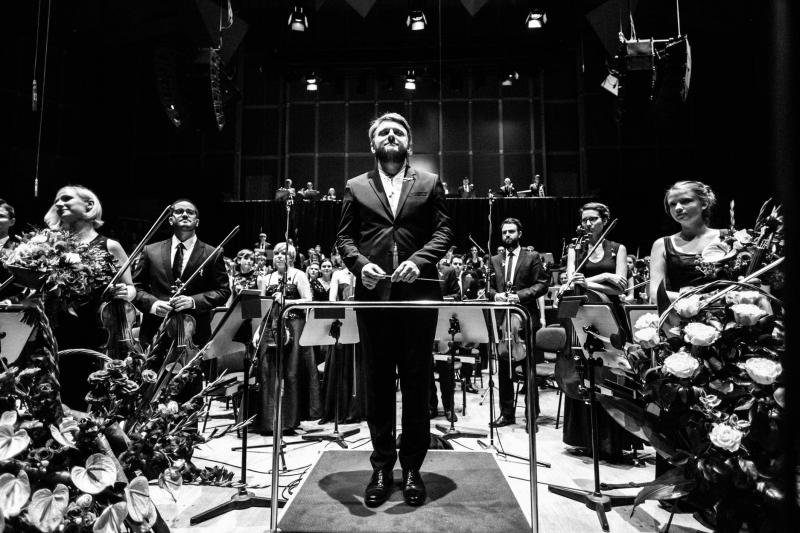I, CULTURE Orchestra, Karabits, Usher Hall, Edinburgh | reviews, news & interviews
I, CULTURE Orchestra, Karabits, Usher Hall, Edinburgh
I, CULTURE Orchestra, Karabits, Usher Hall, Edinburgh
Music trumps politics in youthful, even joyous Shostakovich 'Leningrad' Symphony

It is easy to be blinded by the sensational history of Shostakovich’s Seventh Symphony, the “Leningrad”. We cannot forget the famous performance by a starving makeshift orchestra in August 1942, at the height of the siege of Leningrad, or the dramatic way in which the Soviet authorities spirited the microfilmed score out of Russia to America via Tehran.
With the current political unrest and military instability on the Russian-Ukrainian frontier, one might expect that a performance of the 'Leningrad' by an Eastern European youth orchestra under the baton of the Ukrainian conductor Kirill Karabits would uncover contemporary resonances of its own, but this was an interpretation in which the music, first and last, spoke for itself, quietly, beautifully, and triumphantly. The I, CULTURE Orchestra, or ICO, was founded in Warsaw in 2011 and draws its players from Poland and the Eastern Partnership states: Armenia, Azerbaijan, Belarus, Georgia, Moldova, and Ukraine. For such a young band, with such young players, the sound is remarkably broad and unified, one or two cloudy brass entries the only discernible difference between this and more established ensembles.
 By any standards it is a huge orchestra, with a high proportion of female players, and the sheer volume of sound in this most noisy of symphonies was enough to impress the most cynical listener. From the first tentative rat-a-tat on the side drum, the Allegretto march grew steadily, inexorably, in power. But for those who seek evil in the unstoppable progress of this trite little tune (above, anti-aircraft machinery during the siege of Leningrad), there was none. With undemonstrative authority, Karabits allowed the music to unfold. The lower strings, whose role can be to rasp and unsettle, added depth and richness to the cacophony. The brass were not strident and militaristic but warm and biscuity.
By any standards it is a huge orchestra, with a high proportion of female players, and the sheer volume of sound in this most noisy of symphonies was enough to impress the most cynical listener. From the first tentative rat-a-tat on the side drum, the Allegretto march grew steadily, inexorably, in power. But for those who seek evil in the unstoppable progress of this trite little tune (above, anti-aircraft machinery during the siege of Leningrad), there was none. With undemonstrative authority, Karabits allowed the music to unfold. The lower strings, whose role can be to rasp and unsettle, added depth and richness to the cacophony. The brass were not strident and militaristic but warm and biscuity.
Much of the apparent naivety of the first movement’s themes is continued in the second, here performed with sweet innocence and charm that few performances achieve, or even attempt. The third movement, largely static, left space for contemplation, with a particularly lovely sound in a cantabile section for the large viola section.
As the symphony blazed its way to the affirmation of its conclusion it felt that a work so often marginalised by critics for its lack of emotional depth was here being celebrated for the simplicity and power of its music alone. It seemed inevitable that as the thud of the great bass drum marked the end, so the near-capacity audience should erupt with the most enthusiastic applause that I have yet heard this Edinburgh Festival, with each section of the orchestra as they were brought to their feet receiving ever louder accolades, particularly the young man on the side drum and the athletic young woman next to him on the timpani.
It would be easy to forget, in the wake of such a performance, the work that preceded it: the Sinfonia elegiaca by Andrzej Panufnik, who died in 1991. This too is a work that concerns itself with war, reflecting the composer’s bleak view that the sacrifice of war has done nothing to bring peace to the world. Spanning just 20 minutes in three linked movements, this is a simple and expressive work whose slow outer movements have something of an English flavour, with expansive but slightly bland harmonies, while the motoric central section speaks of the inhumanity of war with a rather polite vehemence. Any slight uncertainty that the players may have felt in interpreting this enigmatic piece was soon dispelled after the interval.
rating
Share this article
The future of Arts Journalism
You can stop theartsdesk.com closing!
We urgently need financing to survive. Our fundraising drive has thus far raised £49,000 but we need to reach £100,000 or we will be forced to close. Please contribute here: https://gofund.me/c3f6033d
And if you can forward this information to anyone who might assist, we’d be grateful.

Subscribe to theartsdesk.com
Thank you for continuing to read our work on theartsdesk.com. For unlimited access to every article in its entirety, including our archive of more than 15,000 pieces, we're asking for £5 per month or £40 per year. We feel it's a very good deal, and hope you do too.
To take a subscription now simply click here.
And if you're looking for that extra gift for a friend or family member, why not treat them to a theartsdesk.com gift subscription?
more Classical music
 theartsdesk at the Lahti Sibelius Festival - early epics by the Finnish master in context
Finnish heroes meet their Austro-German counterparts in breathtaking interpretations
theartsdesk at the Lahti Sibelius Festival - early epics by the Finnish master in context
Finnish heroes meet their Austro-German counterparts in breathtaking interpretations
 Classical CDs: Sleigh rides, pancakes and cigars
Two big boxes, plus new music for brass and a pair of clarinet concertos
Classical CDs: Sleigh rides, pancakes and cigars
Two big boxes, plus new music for brass and a pair of clarinet concertos
 Waley-Cohen, Manchester Camerata, Pether, Whitworth Art Gallery, Manchester review - premiere of no ordinary violin concerto
Images of maternal care inspired by Hepworth and played in a gallery setting
Waley-Cohen, Manchester Camerata, Pether, Whitworth Art Gallery, Manchester review - premiere of no ordinary violin concerto
Images of maternal care inspired by Hepworth and played in a gallery setting
 BBC Proms: Barruk, Norwegian Chamber Orchestra, Kuusisto review - vague incantations, precise laments
First-half mix of Sámi songs and string things falters, but Shostakovich scours the soul
BBC Proms: Barruk, Norwegian Chamber Orchestra, Kuusisto review - vague incantations, precise laments
First-half mix of Sámi songs and string things falters, but Shostakovich scours the soul
 BBC Proms: Alexander’s Feast, Irish Baroque Orchestra, Whelan review - rapturous Handel fills the space
Pure joy, with a touch of introspection, from a great ensemble and three superb soloists
BBC Proms: Alexander’s Feast, Irish Baroque Orchestra, Whelan review - rapturous Handel fills the space
Pure joy, with a touch of introspection, from a great ensemble and three superb soloists
 BBC Proms: Moore, LSO, Bancroft review - the freshness of morning wind and brass
English concert band music...and an outlier
BBC Proms: Moore, LSO, Bancroft review - the freshness of morning wind and brass
English concert band music...and an outlier
 Willis-Sørensen, Ukrainian Freedom Orchestra, Wilson, Cadogan Hall review - romantic resilience
Passion, and polish, from Kyiv's musical warriors
Willis-Sørensen, Ukrainian Freedom Orchestra, Wilson, Cadogan Hall review - romantic resilience
Passion, and polish, from Kyiv's musical warriors
 BBC Proms: Faust, Gewandhausorchester Leipzig, Nelsons review - grace, then grandeur
A great fiddler lightens a dense orchestral palette
BBC Proms: Faust, Gewandhausorchester Leipzig, Nelsons review - grace, then grandeur
A great fiddler lightens a dense orchestral palette
 BBC Proms: Jansen, Royal Concertgebouw Orchestra, Mäkelä review - confirming a phenomenon
Second Prom of a great orchestra and chief conductor in waiting never puts a foot wrong
BBC Proms: Jansen, Royal Concertgebouw Orchestra, Mäkelä review - confirming a phenomenon
Second Prom of a great orchestra and chief conductor in waiting never puts a foot wrong
 BBC Proms: Royal Concertgebouw Orchestra, Mäkelä review - defiantly introverted Mahler 5 gives food for thought
Chief Conductor in Waiting has supple, nuanced chemistry with a great orchestra
BBC Proms: Royal Concertgebouw Orchestra, Mäkelä review - defiantly introverted Mahler 5 gives food for thought
Chief Conductor in Waiting has supple, nuanced chemistry with a great orchestra
 Dunedin Consort, Butt / D’Angelo, Muñoz, Edinburgh International Festival 2025 review - tedious Handel, directionless song recital
Ho-hum 'comic' cantata, and a song recital needing more than a beautiful voice
Dunedin Consort, Butt / D’Angelo, Muñoz, Edinburgh International Festival 2025 review - tedious Handel, directionless song recital
Ho-hum 'comic' cantata, and a song recital needing more than a beautiful voice
 Classical CDs: Dungeons, microtones and psychic distress
This year's big anniversary celebrated with a pair of boxes, plus clarinets, pianos and sacred music
Classical CDs: Dungeons, microtones and psychic distress
This year's big anniversary celebrated with a pair of boxes, plus clarinets, pianos and sacred music

Add comment